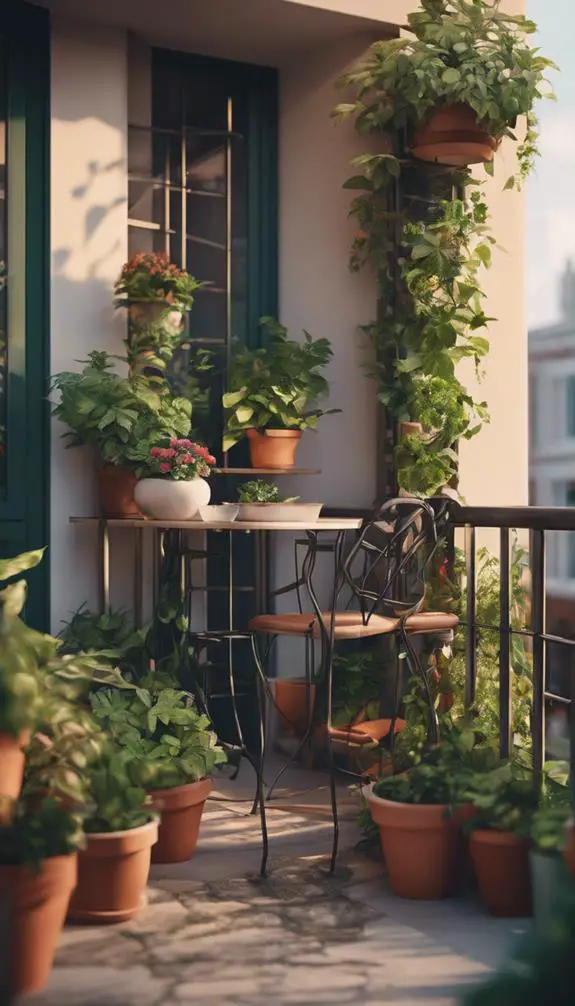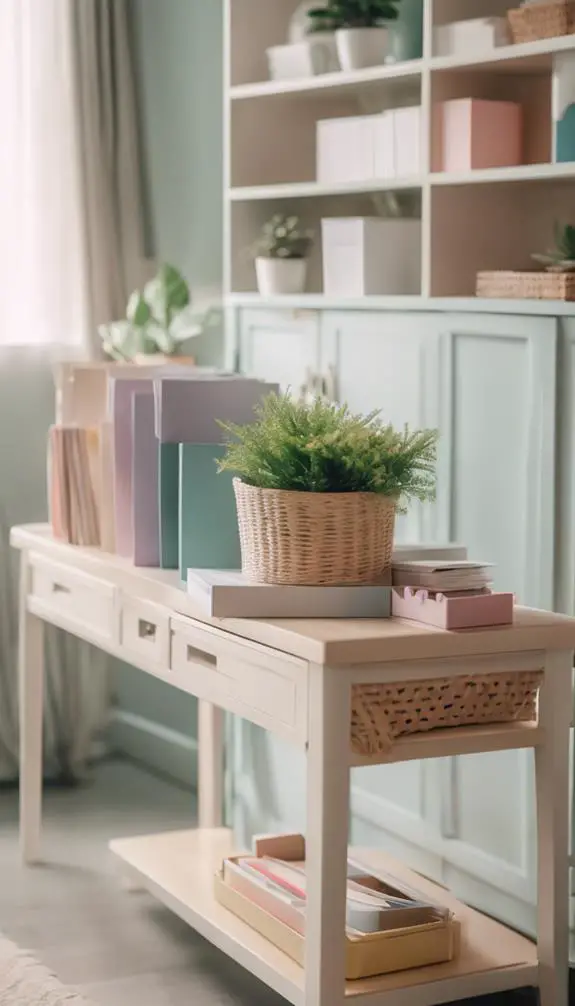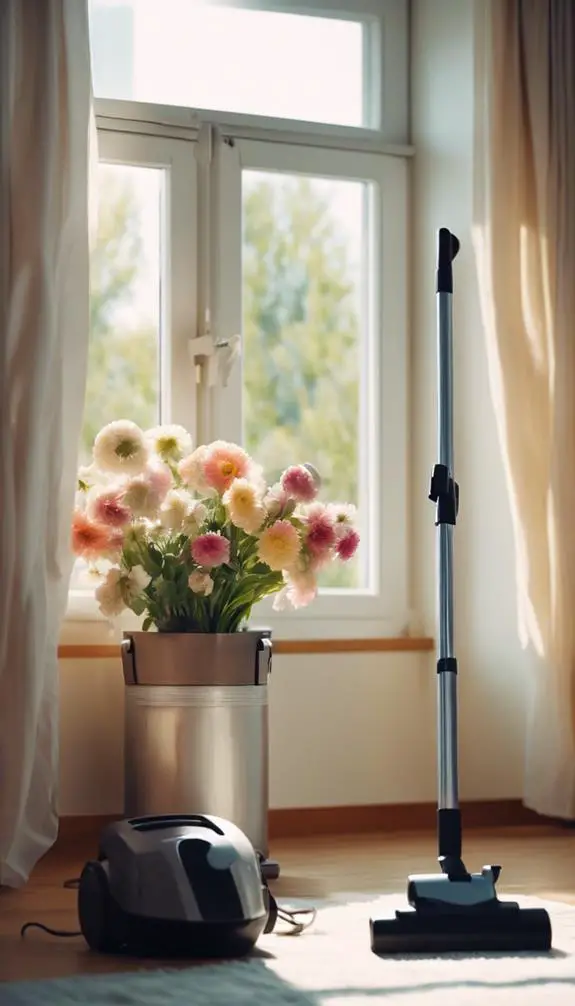As you stand in your compact backyard or gaze out at your tiny balcony, you might think that gardening is out of the question. But think again! With a little creativity and the right strategies, you can turn even the smallest of spaces into a lush oasis. By identifying the sunniest spots and utilizing vertical and container gardening techniques, you can coax a surprising amount of beauty and bounty from your limited area. But that's just the beginning – what if you could also squeeze in a few compact fruit trees or create a stunning window box display? The possibilities are endless, and we're about to explore them.
Summary
- Evaluate your space's layout and identify areas receiving the most sunlight to determine the best spots for plants and outdoor decor.
- Use vertical and container gardening to create a lush oasis in small spaces, such as wall planters, living walls, and patio container gardening.
- Hang baskets and window boxes to add elegance and texture to your outdoor space, choosing flowers and materials that complement the surroundings.
- Consider compact fruit trees, which are specifically bred for small spaces, and prune them regularly to maintain a compact shape and promote healthy growth.
- Optimize natural light in your garden by pruning or arranging plants, using mirrors or reflective surfaces, and supplementing with artificial light if necessary.
Optimize Your Outdoor Space
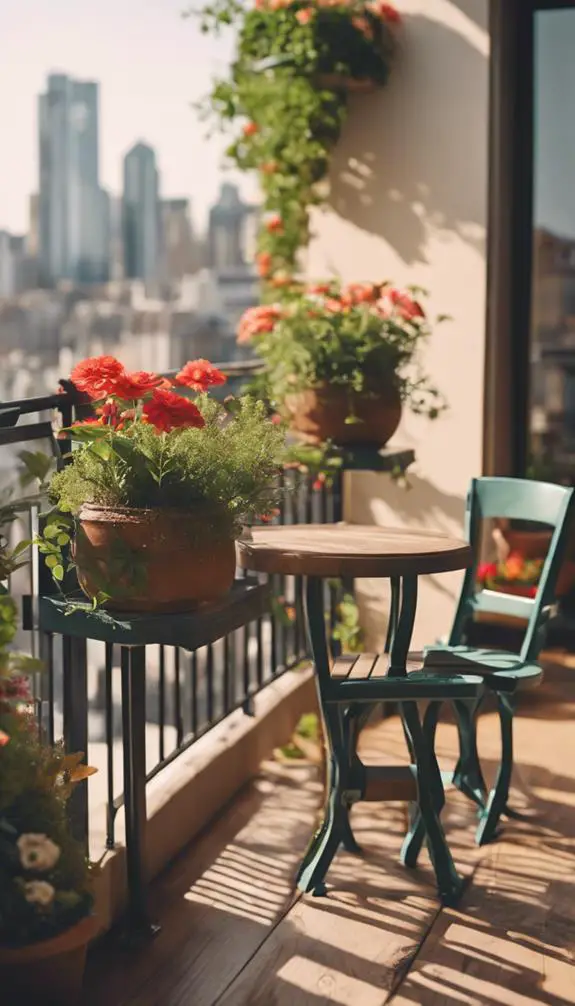
To make the most of your small outdoor space, start by evaluating its layout and identifying areas that receive the most sunlight.
This will help you determine the best spots for your plants and outdoor decor. Consider the shape and size of your space, as well as any obstacles like walls or stairs.
Then, think about how you want to use your space – do you want a seating area, a dining area, or a garden bed?
Effective space planning will help you create a functional and inviting outdoor area. By optimizing your layout, you can create a beautiful and functional space that makes the most of every square foot.
Vertical Gardening Solutions
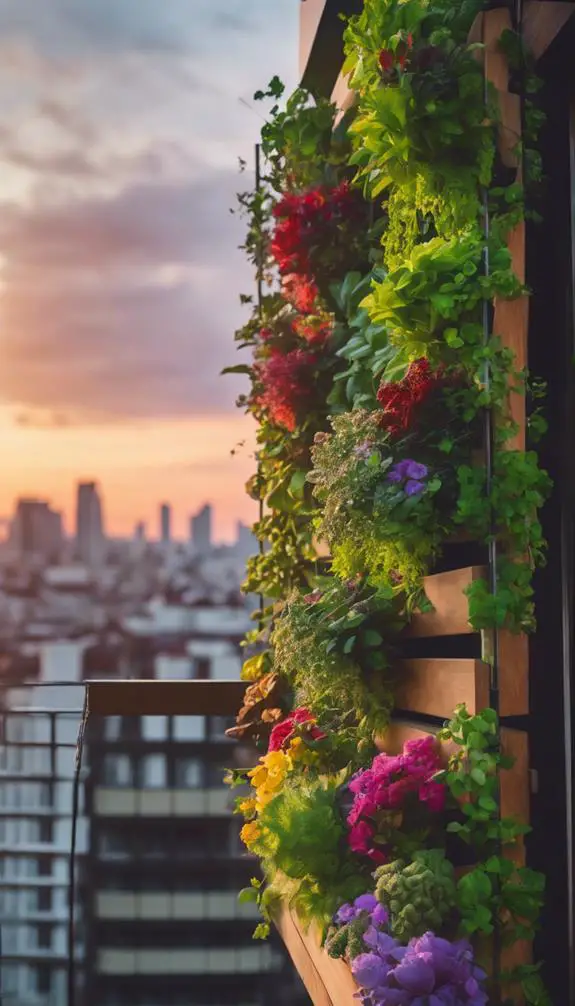
Now that you've optimized your outdoor space, it's time to think vertically.
You can create a lush oasis in even the smallest of spaces with vertical gardening solutions. Wall planters are a great way to add some greenery to your walls, providing a beautiful display of plants while taking up minimal space.
For a more dramatic effect, consider installing a living wall, where plants are integrated into the wall itself. This not only looks stunning but also helps purify the air and regulate the temperature.
With a little creativity, you can turn any blank wall into a thriving garden, making the most of your small space.
Window Box Wonders
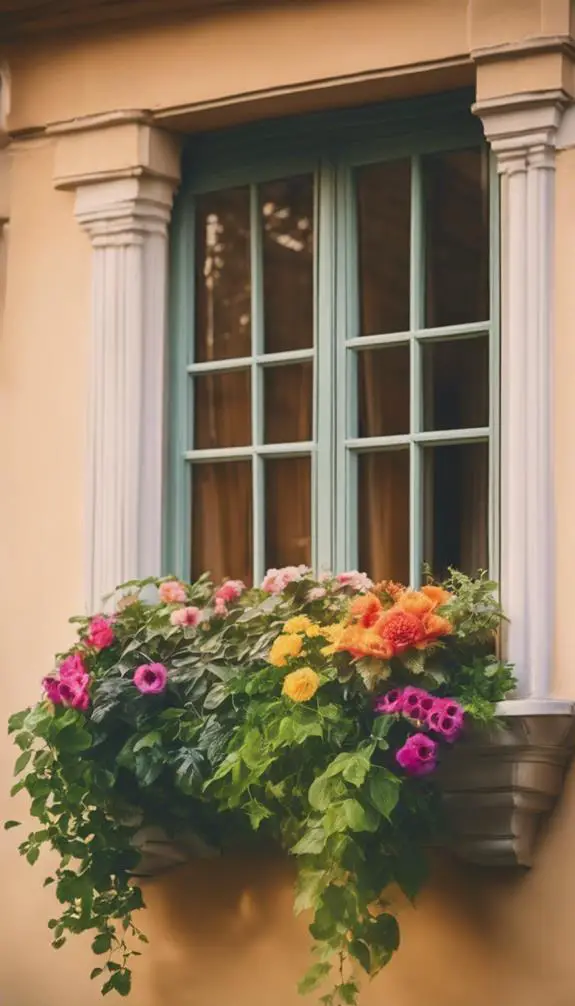
Beyond your walls, another opportunity awaits to maximize your small space: your windows.
You can transform them into stunning window boxes that add a touch of elegance to your home's exterior while showcasing your green thumb. Choose window decor that complements your home's style, and don't be afraid to experiment with seasonal themes.
In the spring, fill your window boxes with vibrant flowers and greenery. In the summer, try an invigorating mix of herbs and succulents. As the seasons change, update your window boxes to reflect the new hues and textures.
With a little creativity, your windows will become a beautiful extension of your small space garden.
Patio Container Gardening

Your patio is a blank canvas waiting for your creative touch, and container gardening is the perfect way to bring it to life.
With patio container gardening, you can create a unique and personalized space that reflects your style.
Choose a theme that resonates with you, such as modern, rustic, or whimsical, and select containers that fit your vision.
Consider sleek and modern planters for a contemporary look or distressed wooden containers for a cozy, vintage vibe.
Don't be afraid to mix and match different container styles to add visual interest.
Balcony Rail Planters
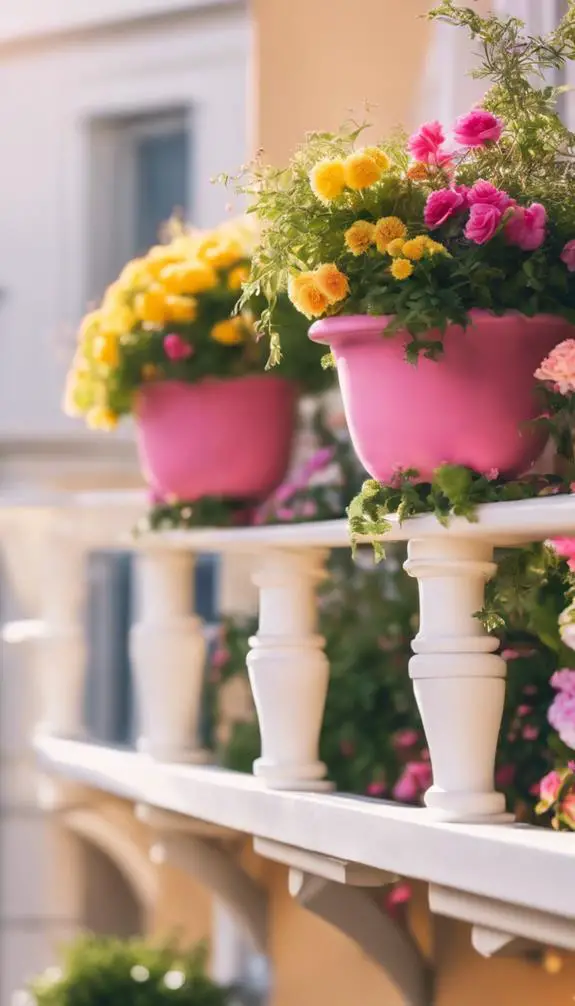
Railings, once a mere barrier, can become a vibrant showcase for your plants with balcony rail planters.
You can attach rail planters to your balcony railing using planter brackets, which come in various styles and materials. This is a great way to maximize your outdoor space, even if it's small.
Choose planters that fit your balcony's style and the type of plants you want to grow. Make sure to select plants that thrive in containers and can tolerate wind, sun, or shade, depending on your balcony's conditions.
With balcony rail planters, you can enjoy a lush garden without taking up valuable floor space.
Indoor Herb Gardens
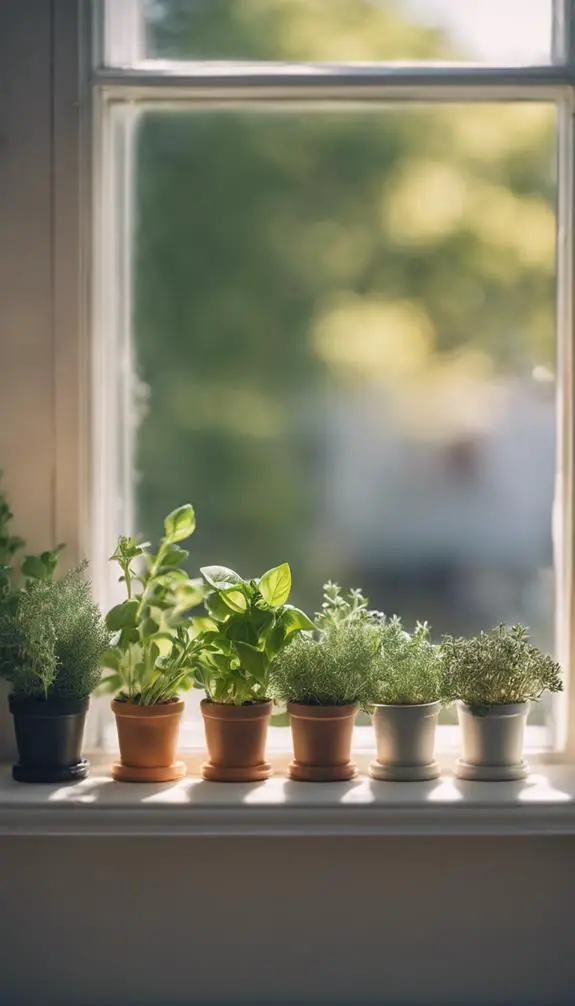
Growing a lush herb garden indoors can be a game-changer for home cooks, adding freshness and flavor to every meal.
When selecting herbs, choose a mix of staples like basil, mint, and parsley, along with some unique varieties to keep things interesting.
Consider the amount of natural light your indoor space receives and choose herbs that thrive in low-light conditions, like chamomile or lemongrass, if needed.
For garden design, think vertically to maximize space.
Use a trellis or a wall-mounted planter to create a visually appealing display.
You can also repurpose a vintage windowsill or a wooden crate to add a touch of whimsy to your indoor herb garden.
DIY Trellis Ideas

To create a visually appealing indoor herb garden, you'll need a trellis that not only provides support for your plants but also adds a decorative touch to your space.
Consider repurposing an old ladder or creating a geometric trellis design using wooden dowels and twine. You can also upcycle an old bike wheel or a vintage window to create a unique trellis that doubles as a garden sculpture.
Get creative with your trellis designs and let your personality shine through. Using a trellis won't only keep your plants organized but also add a touch of whimsy to your indoor herb garden.
With a little imagination, you can create a beautiful and functional trellis that takes your indoor herb garden to the next level.
Space-Saving Vegetable Gardens

Freedom in a small space comes when you learn to maximize every inch, and that's precisely what space-saving vegetable gardens are all about.
By choosing the right vegetable selection, you can make the most of your limited space. Opt for compact or dwarf varieties that mature quickly, such as patio tomatoes, bush beans, or leaf lettuce.
Intensive planting is another key strategy – plant vegetables close together to reduce waste and increase yields. Use a square foot gardening layout to visualize your space and plan accordingly.
With a little creativity, you can grow a bountiful harvest in even the smallest of spaces.
Microgreens for Small Spaces
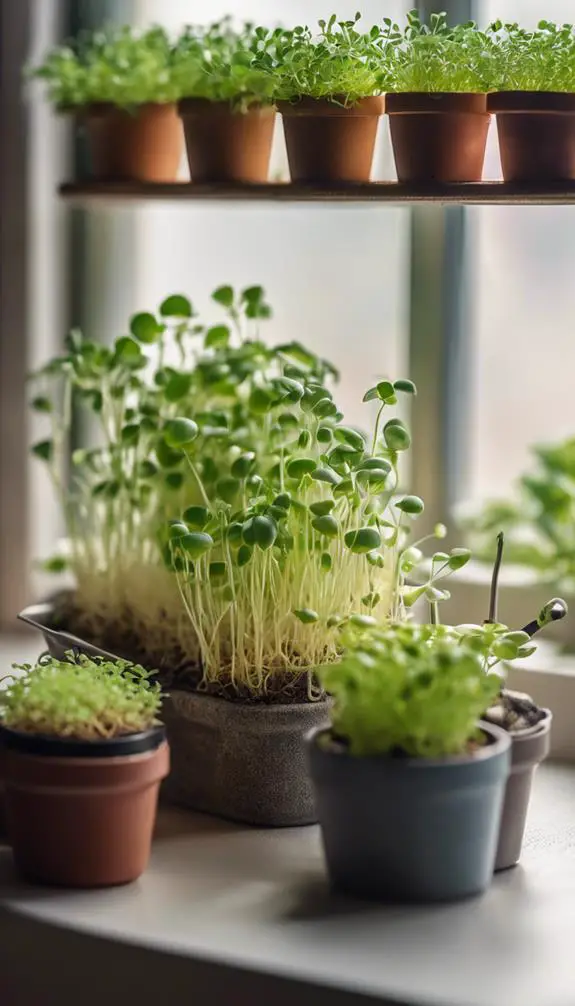
You can grow microgreens indoors, even in the smallest of spaces, and enjoy a continuous harvest by planting them in succession.
Since microgreens are ready to eat in as little as 7-10 days, you'll be harvesting them daily to make room for the next batch.
This fast-paced growing cycle allows you to experiment with different varieties and flavors, keeping your salads and sandwiches fresh and exciting.
Growing Microgreens Indoors
Harvesting fresh greens in the dead of winter or in a tiny apartment might seem like a fantasy, but microgreens make it a reality.
You can grow them indoors, even without a green thumb, and reap their numerous benefits. Microgreens are packed with nutrients, containing up to 40 times more vitamins and antioxidants than their mature counterparts.
When selecting a soil, look for a good quality potting mix specifically designed for microgreens. Avoid using soil from your outdoor garden, as it may contain contaminants that can hinder growth.
With the right soil and a little care, you'll be enjoying fresh, nutritious microgreens in no time. Plus, they're incredibly versatile and can be used as a garnish, added to salads, or blended into smoothies.
Easy to Harvest Daily
Savor the satisfaction of snipping a fresh batch of microgreens daily, right in your own small space.
Microgreens are perfect for small space gardening, requiring minimal care and space. You'll enjoy daily bites of fresh greens, adding a burst of flavor and nutrition to your meals.
Harvest them in as little as 7-10 days, and you'll be amazed at how quickly they grow. Simply snip off the leaves with scissors, leaving the roots intact, and you'll have a continuous supply of fresh greens.
With microgreens, you can have a constant harvest, enjoying the satisfaction of growing your own food, even in the smallest of spaces.
Hanging Basket Inspiration

When you're choosing a hanging basket, remember that size matters – a larger basket can hold more soil and plants, but may be heavier and harder to hang.
You'll also want to think about the type of flowers you want to feature, as some trailing varieties will cascade beautifully over the sides, while others will grow upright and tall.
Basket Size Matters
Pick out a hanging basket that's the right size for your small space gardening needs, and you'll be well on your way to creating a lush, thriving display.
Consider the space where you'll be hanging your basket and choose a size that complements it. Larger baskets can make a statement, but smaller ones can be just as effective in smaller spaces.
Think about the Basket Materials you'll need – will you opt for durable plastic, rustic wicker, or modern metal?
Don't forget about Handle Options, like sturdy chains or comfortable grips, which can make a big difference in how easily you can move your basket around.
Flower Choice Counts
You've got your perfect hanging basket, now it's time to think about what'll make it truly shine – the flowers!
When it comes to flower choice, you've got to ponder your personal preferences and the season.
Do you love vibrant colors or soft pastels? Are you drawn to delicate blooms or statement flowers?
Whatever your style, seasonal blooms are a great way to keep your hanging basket fresh and exciting.
Ponder planting flowers that thrive in the current season, such as petunias in the summer or pansies in the spring.
Utilizing Dead Space

Most small gardens have areas that are often overlooked or underutilized, such as the space between pavers, beneath trees, or alongside fences.
You can turn these hidden corners into secret shelves for plants. For example, use the space between pavers to plant creeping thyme or succulents that can thrive in tight spaces.
Beneath trees, create a shade garden with ferns, hostas, or impatiens. Alongside fences, train vines or climbing plants like clematis or ivy to grow upwards.
Compact Fruit Trees

By repurposing hidden corners of your garden, you've tapped new opportunities for growth.
Now, it's time to explore the world of compact fruit trees. These miniature marvels are specifically bred for small spaces, producing full-sized fruit on dwarfed root systems.
When selecting a tree, consider factors like climate, soil type, and desired fruit yield. Don't be afraid to get creative with fruit pruning – it's essential for maintaining a compact shape and promoting healthy growth.
With proper care, your compact fruit tree will thrive, providing a bountiful harvest in even the smallest of spaces.
Lighting for Small Gardens

You'll want to make the most of natural light in your small garden, so think about how you can optimize the sunlight that filters in.
Consider the direction your garden faces and how you can prune or arrange plants to maximize their exposure. Once you've made the most of natural light, you can also explore artificial light options to supplement and enhance your garden's growth.
Natural Light Optimization
In lieu of sprawling outdoor spaces, small gardens often rely on clever natural light optimization to thrive.
As you plan your small garden, consider the sun's direction to maximize natural light. If your garden receives direct sunlight, use mirrors or reflective surfaces to bounce light onto areas that receive less sun.
This light reflection technique can make a significant difference in plant growth. Observe how sunlight enters your garden throughout the day and adjust your plant placement accordingly.
Artificial Light Options
Supplementing natural light with artificial options can be a game-changer for small gardens, especially those with limited sunlight.
You can use light therapy to stimulate plant growth and development. Grow lamps are a popular choice, offering a focused beam of light that can be directed at specific plants. They're energy-efficient and come in a range of spectrums, from cool blue to warm red.
Some grow lamps even mimic natural daylight, providing a broader spectrum of light. By incorporating artificial light options into your small garden, you can extend the growing season, increase yields, and enjoy a more vibrant, thriving space.
Experiment with different types of grow lamps to find the best fit for your plants and watch them flourish.
FAQs
Can I Grow Vegetables in a Small Space With Poor Soil Quality?
You can still grow veggies in poor soil! Add soil amendments like compost or manure to improve quality. Consider vertical planters to maximize space, and don't be afraid to get creative – you'll be harvesting fresh produce in no time!
How Often Should I Water My Small Space Garden in Summer?
During summer's heat, you'll want to water wisely. Check your water gauges daily, and stick to a consistent summer schedule, watering every 2-3 days, or when the top 2-3 inches of soil feel dry to the touch.
Are There Any Pest Control Methods Safe for Small Gardens?
You'll want to explore natural deterrents like neem oil, garlic spray, and soap solutions to keep pests at bay. For tougher issues, consider organic pesticides like Bt or pyrethrin to safeguard your garden without harming the environment.
Can I Use Artificial Lighting for My Indoor Small Space Garden?
You can definitely use artificial lighting to boost your indoor garden's growth! Consider light therapy with grow lamps, which mimic natural sunlight, to provide the necessary spectrum and intensity for your plants to thrive.
How Do I Prevent Fungal Diseases in a Small, Humid Garden?
You'll want to prioritize air circulation in your humid garden to prevent fungal diseases. Try spacing plants apart and using fans to improve airflow. Don't forget to sterilize your soil regularly to kill off any lurking spores – it's a simple step that'll save you headaches down the line!
Conclusion
You've transformed your small space into a lush oasis, and now it's time to reap the rewards! With these small space gardening ideas, you'll be enjoying fresh fruits and veggies, and basking in the serenity of your outdoor haven. Don't be afraid to experiment and get creative – every corner, nook, and cranny is an opportunity to grow something beautiful. Happy gardening, and get ready to savor the fruits of your labor!


